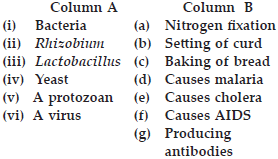Microorganism (Biology) Class 8 - NCERT Questions
Fill in the blanks:
(A) Microorganisms can be seen with the help of a________.
(B) Blue green algae fix _________directly from air to enhance fertility of soil.
(C) Alcohol is produced with the help of _____________.
(D) Cholera is caused by _____________.
(A) microscope
(B) atmospheric nitrogen
(C) yeast
(D) bacteria.
Tick the correct answer.
(A) Yeast is used in the production of
(i) sugar
(ii) alcohol
(iii) hydrochloric acid
(iv) oxygen.
(B) The following is an antibiotic
(i) sodium bicarbonate
(ii) streptomycin
(iii)alcohol
(iv) yeast.
(C) Carrier of malaria-causing protozoan is
(i) female Anopheles mosquito
(ii) cockroach
(iii) housefly
(iv) butterfly.
(D) The most common carrier of communicable diseases is
(i) ant
(ii) housefly
(iii) dragonfly
(iv) spider.
(E) The bread or idli dough rises because of
(i) heat
(ii) grinding
(iii) growth of yeast cells
(iv) kneading
(F) The process of conversion of sugar into alcohol is called
(i) nitrogen fixation
(ii) moulding
(iii) fermentation
(iv) infection.
(A) (ii)
(B) (ii)
(C) (i)
(D) (ii)
(E) (iii)
(F) (iii).
Match the organisms in Column A with their action in Column B.

(i) - (E)
(ii) - (A)
(iii) - (B)
(iv) - (C)
(v) - (D)
(vi) - (F).
Can microorganisms be seen with the naked eye? If not, how can they be seen?
SOLUTION:Microorganisms are very small in size. They are so small that they cannot be seen with naked eyes. A microscope has to be used to see these organisms. Therefore, they are called microorganisms.
Q 5.What are the major groups of micro-organisms?
SOLUTION:Microorganisms can mainly be divided into five groups:
(i) Bacteria, (ii) Fungi, (iii) Protozoa, (iv) Algae, (v) Virus.
Name the microorganisms which can fix atmospheric nitrogen in the soil.
SOLUTION:Bacteria like Rhizobium, Azotobacter and blue green algae like Anabaena and Nostoc can fix atmospheric nitrogen in the soil in form of nitrogenous compounds.
Q 7.Write 10 lines on the usefulness of micro-ganisms in our lives.
SOLUTION:Microorganisms are very useful to us. They help us in following ways:
(i) Microorganisms help us in food sector. They are used for curdling of milk, preparation of bread, cake, etc.
(ii) Microorganisms are used to produce alcohol at large scale.
(iii) They are also used to produce wine.
(iv) Yeast is used in bakeries.
(v) They are also used as preservatives for food items.
(vi) They are used to make different medicines, especially the antibiotics.
(vii) Microorganisms are used to prepare vaccines for various diseases.
(viii) They are useful for agriculture sector, as they enhance the fertility of soil by fixing nitrogen.
(ix) They work as natural cleaners, as they decompose the dead bodies of plants and animals.
(x) Microorganisms prepare manures by decomposing dead bodies of plants and animals.
Write a short paragraph on the harms caused by microorganisms.
SOLUTION:Microorganisms can prove very harmful to us, as they cause a number of diseases in human, plants and animals. Diseases in humans like common cold, tuberculosis, measles, chicken pox, polio, cholera, typhoid, hepatitis B, malaria, etc. are caused by microorganisms. Some serious diseases like anthrax is also caused in animals by the microbes. Microbes also cause diseases of plants like blights in potatoes and red rot in sugarcane, etc. They also reduce the yield. Microbes grow on food products and render them unfit for consumption. Consumption of such food causes food poisoning. Microbes also spoil clothings and leather products.
Q 9.What are antibiotics? What precautions must be taken while taking antibiotics?
SOLUTION:Medicines taken to kill or stop the growth of harmful or disease causing microbes in human body are called antibiotics. Antibiotics are very useful as only antibiotics can save us from many microbial infections and diseases. Antibiotics are made from fungi and bacteria. Alexander Fleming discovered the first antibiotic called penicillin in 1929. Now-a-days a number of antibiotics are used to cure a variety of human and animal diseases.
Streptomycin, tetracycline, erythromycin etc. are some commonly used antibiotics.
Antibiotics should only be taken when advised by a qualified physician. They should only be taken when needed, otherwise, they become less effective for future use.